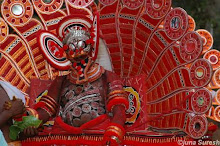
THEYYAM
Theyyam is one of the most exceptional and popular ritual dance form of north Kerala particularly performed by Hindus in temples or shrines. It is also a reflection of the communal harmony as in some Theyyams, few Muslim characters are included while performing.
Theyyam is considered very important and communal event in various parts of Kasaragod and Kannur districts of Kerala.
Villagers of different castes, recently witnessed one such event, named Mokri Pokker Theyyam held at Mallom Kollom Temple at Vellikundh near Kasaragod district in Kerala.
In this ritual form, a Hindu performer ...
Gods come near to devotees. They speak to them, hug them with immortal blessing. Here the distance of heaven and earth dissolves, in nature. The fame, God’s own country, which Kerala possess for many centuries, becomes literally specific too in such situations. Theyyam festival has begun in Northern districts of Kerala!
Kaliyattom and Thirayattoms mark the Kavu festivals of Northern Malabar. Theyyam, said to be part of Kerala’s folk art is rich in its colour, light, and performance. There is dance, art, story telling and fortune - telling ceremonies incorporated with Theyyam. The interaction of deities with devotees is a marvellous sight of Malabar villages.
Hundreds of thousands of deities around Malabar is appearing before the believers during the season which begin in February. Those who live outside the villages return home with nostalgic memories of the unique celebrations during the Theyyam festivals. Sleepless nights and restless days would become a special mark of the cultural extravaganza.
Theyyam and Thira forms of art thus become a blend of devotion and folk culture; a spectacular festival of Northern villages. Deities in the temples come along with Karanavars of tharawad to celebrate the festivals. Bhaghavathy, Naga Bhaghavathy, Chamundi, Kuttichathan, Gulikan, Karanavar…the names and definitions of Theyyam goes wide.
As for every other celebration, children are the most excited group. They mock and roar at the deities in red and shining costumes with many ornaments and artistic matters, reach near them. Dance and action of Theyyam energizes the whole devotee society.
The form of Theyyam is symbol of God or Goddess inside the temple. During the festival season, deities come out of the sanctum sanctorum to meet its people and bless them directly. This is the age old belief of Kerala. Devotees are thrilled to see the God in front of them with all kinds of ornaments. All the villagers would begin their preparation many days before the festival of their nearby temples. They would make their home clean and tidy. Make the mind and body ready for the village festival.
The selected village folk, undergoing fasting, collect tender coconuts, chain them on long sticks, carry on their shoulders and arrive at the temple premises. While Theyyam as in the form of deity prepares for receiving the group.
The reception at the entrance of temples and the union of the folk and gang in one side and the deity and temple authorities other side make a special celebrative mood. Most often this kind of get together takes place in the night with crimsons and marvellous fireworks.
The non-stop Theyyam festival usually begins immediately after sunset and continues for three or four days. It depends on the number of deities. Whenever the curtain of one festival falls, the folk would wait impatiently for the next season to come. The innocence of village life is reflected all over in the Theyyam festival.
History
According to the legendary Keralolpathi, Parasurama sanctioned festivals like Kaliyattam, Puravela and Daivattam or Theyyattam to the people of the Malabar region. He also assigned the responsibility of performing the Theyyam dance to the indigenous tribal communities like Malayar, Panan, Vannan and Velan. "There can be no doubt", say Bridget and Raymond Alchin, "that a very large part of this modern folk religion is extremely ancient and contains traits which originated ruing the earliest periods of Neolithic, Chalcolithic settlement and expression" (The Birth of Indian Civilization 1968 p. 3039), and indeed, Theyyam is representative of a form of Hinduism (albeit non-Brahminical) having been practiced by tribal communities since time immemorial. This form of worship, often involving liquor and meat as offerings to Bhagawathi, Shiva, Vishnu, co-existed with the Sattvic rituals practiced by Nambudiri Brahmins in temples. In fact, Theyyam was nearly always sponsored by members of the ruling class, such as Nair feudal chiefs, and achieved much prominence, therefore Theyyam festivals and Temple festivals were celebrated with equal vigour.










No comments:
Post a Comment